Towards Sustainable Digital Agriculture for Smallholder Farmers: A Systematic Literature Review
Abstract
:1. Introduction
2. Methodology
2.1. Identification of the Research Articles
2.1.1. Construction of the Search Terms
2.1.2. Identification of the Data Sources
2.1.3. Inclusion and Exclusion Criteria
2.2. Coding and Classification Framework
3. Results and Analysis of the Systematic Literature Review
3.1. Context
3.2. Continents of Origin
3.3. Focus on Digital Ecosystems for Smallholder Farmers
3.4. Research Methods
3.5. Current Research Performed on Digital Ecosystems for Smallholder Farmers
3.6. Dimensions Emerging from the Systematic Literature Review
3.6.1. What Are the Challenges of Digital Agriculture Ecosystems in Relation to Smallholder Farmers?
3.6.2. How Are Smallholder Farmers Using Digital Solutions in Their Businesses?
3.6.3. What Are the Factors That Influence the Uptake of Digital Solutions by Smallholder Farmers?
3.6.4. What Are the Benefits of Digital Solutions for Smallholder Farmers?
3.6.5. What Is the Level of Access to and Uptake of Digital Solutions by Smallholder Farmers?
4. Recommendation
- How can a digital agriculture ecosystem be developed for smallholder farmers in the agriculture sector of sub-Saharan Africa?
- How can a digital agriculture ecosystem that considers contextual challenges be developed for sub-Saharan smallholder farmers?
- What is the definition of smallholder farmers in the context of the sub-Saharan agriculture sector?
- What is the level of digital literacy or skills of smallholder farmers?
- Do smallholder farmers have access to digital infrastructure?
- What is the impact of the digital infrastructure on digital solutions uptake by smallholder farmers?
- How can a digital agriculture ecosystem for smallholder farmers be developed that focuses on all the elements of the ecosystem and considers contextual challenges facing these farmers?
- How can government develop a supportive legal infrastructure for smallholder farmers to enable digital transformation?
- What are the political and social ramifications impeding smallholder farmers from taking up and using digital solutions?
- How can government assist with the standardization and interoperability of digital solutions for smallholder farmers?
- How can a digital solution for smallholder farmers’ development incorporate the local languages of smallholder farmers?
- How can a digital solution for smallholder farmers be developed in a way that considers first-generation farmers?
- What is needed to educate smallholder farmers on developing digital solutions?
- How can the value of digital solutions for smallholder farmers be communicated to them?
- What can be done to bring the cost of communication and data rates down for smallholder farmers?
- How can digital solutions for smallholder farmers be developed in a way that increases the participation of women in smallholder farming?
- How should digital solutions be communicated in a way that creates awareness for smallholder farmers?
- How do digital solutions for smallholder farmers consider agriculture extension services?
- What is the impact of land tenure issues on the uptake of and access to digital solutions by smallholder farmers?
- How should digital solutions for smallholder farmers be developed in a way that considers land tenure issues?
- What is the effect of telecommunication and electrical infrastructure on digital solutions for smallholder farmers?
- How should digital solutions for smallholder farmers be developed in a way that considers the challenges posed by telecommunication and electrical infrastructure?
- How can digital solutions for smallholder farmers be developed in a way that takes into account the remote locations of farmers?
- What is the applicability, relevancy, and value proposition of digital solutions to various smallholder farmer settings and contexts?
- How do smallholder farmers want digital solutions to be introduced to them?
- How should awareness of digital solutions for smallholder farmers be created?
- How can timely, up-to-date data and knowledge about digital solutions for smallholder farmers be achieved through a digital agriculture ecosystem?
- How can the perceptions and behaviors of smallholder farmers toward digital solutions be changed?
- How can training on digital solutions be developed and provided for older smallholder farmers?
- What is the level of knowledge and attitudes of smallholder farmers toward digital solutions?
- How can the inclusion of youth in agriculture education and training on digital solutions for smallholder farmers be achieved?
- What is the level of knowledge of smallholder farmers on digital innovation within digital agriculture solutions?
- Do smallholder farmers have the business knowledge and capabilities required for them to uptake digital solutions?
- How can digital solutions be contextualized for the smallholder farmers’ contexts?
- How can business model innovation assist with gender-responsive digital solutions for smallholder farmers?
- How can developed digital solution offerings be made available off-the-shelf or through DIY for smallholder farmers?
- How can the design of digital solutions for smallholder farmers be developed to ensure enhanced usability/ease of use and reproducibility?
- What role can government and private sector partnerships (public–private partnerships) and partnerships with community-based farmers’ associations play in the development of digital solutions for smallholder farmers?
- What is the usefulness and utility of the offered digital solutions for smallholder farmers?
- How can government develop and implement policies that are geared toward supporting smallholder business environments and contexts?
- How can digital solutions for smallholder farmers be developed in such a way that they are affordable for smallholder farmers?
- How can the development of digital solutions ensure access to mobile savings accounts and credit?
- What solutions can be put in place to ensure connectivity and mobile broadband access to enable the uptake and use of digital solutions by smallholder farmers?
- How is the availability of spectrum affecting the access to and uptake of digital solutions by smallholder farmers?
- How can trust in digital solutions be established among the smallholder farming community?
- How should the benefits of digital solutions be communicated to smallholder farmers to facilitate the uptake of such solutions?
- How does one develop a digital agriculture ecosystem so that it delivers the identified benefits of using digital solutions for smallholder farmers?
- How can the age of older smallholder farmers be taken into account when communicating the benefits of digital solutions to such farmers?
- How should the benefits of digital solutions be communicated to young people when research has revealed that they are not interested in farming?
- How can the benefits of digital solutions be communicated in a way that attracts young people to farming?
- Which digital agriculture platforms do smallholder farmers have access to and which are they taking up?
- What is the level of access to and uptake of agricultural business model innovations by smallholder farmers?
- What is the level of access to digital infrastructure by smallholder farmers?
- What is the level of access to and uptake of 4IR technologies by smallholder farmers?
- How is affordability affecting the access to and uptake of digital solutions by smallholder farmers?
5. Conclusions
Supplementary Materials
Author Contributions
Funding
Institutional Review Board Statement
Informed Consent Statement
Data Availability Statement
Conflicts of Interest
Appendix A. Specific Terms and Search Strings
- Smallholder Farmers OR
- Small-Scale Farmers OR
- Subsistence Farmers OR
- Resource Poor Farmers OR
- Low-Input Farmers OR
- Low-Income Farmers OR
- Small Micro and Medium Enterprises Farmers OR
- SMMEs Farmers OR
- Small Business Farmers OR
- Small and Medium Sized Enterprise Farmers OR
- SMEs Farmers OR
- Small and Medium Business Farmers OR
- SMBs Farmers
- Digital Ecosystem OR
- Artificial Intelligence OR
- Cloud Computing OR
- Internet of Things OR
- Smart Sensors OR
- Remote Sensing OR
- Big Data OR
- Mobile
- 1.
- Digital Ecosystem OR Artificial Intelligence OR Cloud Computing OR Internet of Things OR Smart Sensors OR Remote Sensing OR Big Data OR Mobile
- 2.
- Smallholder Farmers AND Digital Ecosystem OR Artificial Intelligence OR Cloud Computing OR Internet of Things OR Smart Sensors OR Remote Sensing OR Big Data OR Mobile
- 3.
- Small-Scale Farmers AND Digital Ecosystem OR Artificial Intelligence OR Cloud Computing OR Internet of Things OR Smart Sensors OR Remote Sensing OR Big Data OR Mobile
- 4.
- Subsistence Farmers AND Digital Ecosystem OR Artificial Intelligence OR Cloud Computing OR Internet of Things OR Smart Sensors OR Remote Sensing OR Big Data OR Mobile
- 5.
- Resource Poor Farmers AND Digital Ecosystem OR Artificial Intelligence OR Cloud Computing OR Internet of Things OR Smart Sensors OR Remote Sensing OR Big Data OR Mobile
- 6.
- Low-Input Farmers AND Digital Ecosystem OR Artificial Intelligence OR Cloud Computing OR Internet of Things OR Smart Sensors OR Remote Sensing OR Big Data OR Mobile
- 7.
- Low-Income Farmers AND Digital Ecosystem OR Artificial Intelligence OR Cloud Computing OR Internet of Things OR Smart Sensors OR Remote Sensing OR Big Data OR Mobile
- 8.
- Small Micro and Medium Enterprise Farmers AND Digital Ecosystem OR Artificial Intelligence OR Cloud Computing OR Internet of Things OR Smart Sensors OR Remote Sensing OR Big Data OR Mobile
- 9.
- SMMEs Farmers AND Digital Ecosystem OR Artificial Intelligence OR Cloud Computing OR Internet of Things OR Smart Sensors OR Remote Sensing OR Big Data OR Mobile
- 10.
- Small Business Farmers AND Digital Ecosystem OR Artificial Intelligence OR Cloud Computing OR Internet of Things OR Smart Sensors OR Remote Sensing OR Big Data OR Mobile
- 11.
- Small and Medium Sized Enterprise Farmers AND Digital Ecosystem OR Artificial Intelligence OR Cloud Computing OR Internet of Things OR Smart Sensors OR Remote Sensing OR Big Data OR Mobile
- 12.
- SMEs Farmers AND Digital Ecosystem OR Artificial Intelligence OR Cloud Computing OR Internet of Things OR Smart Sensors OR Remote Sensing OR Big Data OR Mobile
- 13.
- Small and Medium Business Farmers AND Digital Ecosystem OR Artificial Intelligence OR Cloud Computing OR Internet of Things OR Smart Sensors OR Remote Sensing OR Big Data OR Mobile
- 14.
- SMBs Farmers AND Digital Ecosystem OR Artificial Intelligence OR Cloud Computing OR Internet of Things OR Smart Sensors OR Remote Sensing OR Big Data OR Mobile.
References
- FAO. The Future of Food and Agriculture: Trends and Challenges. 2014. Available online: https://www.fao.org/3/i6583e/i6583e.pdf (accessed on 4 June 2022).
- Pawlak, K.; Kołodziejczak, M. The role of agriculture in ensuring food security in developing countries: Considerations in the context of the problem of sustainable food production. Sustainability 2020, 12, 5488. [Google Scholar] [CrossRef]
- Gomez, S. The Role of Smallholder Farms in Food and Nutrition Security; Springer: Cham, Switzerland, 2020. [Google Scholar] [CrossRef]
- Lowder, S.K.; Skoet, J.; Singh, S. What Do We Really Know About the Number and Distribution of Farms and Family Farms in the World? Background Paper for the State of Food and Agriculture 2014; FAO: Rome, Italy, 2014. [Google Scholar]
- Vignola, R.; Harvey, C.A.; Bautista-Solis, P.; Avelino, J.; Rapidel, B.; Donatti, C.; Martinez, R. Ecosystem-based adaptation for smallholder farmers: Definitions, opportunities and constraints. Agric. Ecosyst. Environ. 2015, 211, 126–132. [Google Scholar] [CrossRef]
- Laborde, D.; Martin, W.; Swinnen, J.; Vos, R. COVID-19 risks to global food security. Science 2020, 369, 500–502. [Google Scholar] [CrossRef] [PubMed]
- National Planning Commission. Our Future–Make It Work. 2011. Available online: https://www.gov.za/sites/default/files/gcis_document/201409/ndp-2030-our-future-make-it-workr.pdf (accessed on 8 June 2023).
- World Bank. World Bank List of Economies. (June 2020). Available online: www.worldbank.org (accessed on 8 June 2023).
- Fanadzo, M.; Ncube, B. Challenges and opportunities for revitalising smallholder irrigation schemes in South Africa. Afr. J. Online Water SA 2018, 44, 436–447. [Google Scholar] [CrossRef]
- Pienaar, L.; Traub, L.N. Understanding the Smallholder Farmer in South Africa: Towards a Sustainable Livelihoods Classification. In Proceedings of the 29th International Conference of Agricultural Economists, Milan, Italy, 8–14 August 2015; pp. 1–36. [Google Scholar]
- Ssozi, J.; Asongu, S.; Amavilah, V.H. The effectiveness of development aid for agriculture in Sub-Saharan Africa. J. Econ. Stud. 2019, 46, 284–305. [Google Scholar] [CrossRef]
- Agyekumhene, C.; de Vries, J.R.; van Paassen, A.; Macnaghten, P.; Schut, M.; Bregt, A. The Role of ICTs in Improving Smallholder Maize Farming Livelihoods: The Mediation of Trust in Value Chain Financing. In Proceedings of the 13th European International Farming System Association Symposium. Theme 4-Smart Technologies in Farming and Food Systems, Chania, Greece, 1–5 July 2018. [Google Scholar]
- FAO. Digital Technologies in Agriculture and Rural Areas, Briefing Paper FAO. 2019. Available online: http://www.fao.org/3/ca4887en/ca4887en.pdf (accessed on 8 June 2022).
- Beriya, A. Digital Agriculture: Challenges and Possibilities in India; Center for Sustainable Development (CSD), Earth Institute, Columbia University: New York, NY, USA, 2020. [Google Scholar]
- Beriya, A. Precision Agriculture to Digital Agriculture: A Literature Review; Center for Sustainable Development (CSD), Earth Institute, Columbia University: New York, NY, USA, 2020. [Google Scholar]
- Amui, L.B.L.; Jabbour, C.J.C.; de Sousa Jabbour, A.B.L.; Kannan, D. Sustainability as a dynamic organizational capability: A systematic review and a future agenda toward a sustainable transition. J. Clean. Prod. 2017, 142, 308–322. [Google Scholar] [CrossRef]
- Lage Junior, M.; Godinho Filho, M. Variations of the kanban system: Literature review and classification. Int. J. Prod. Econ. 2010, 125, 13–21. [Google Scholar] [CrossRef]
- Adam, I.O.; Musah, A. Small and medium enterprises (SMEs) in the Cloud in developing countries: A synthesis of the literature and future research directions. J. Manag. Sustain. 2015, 5, 115–139. [Google Scholar] [CrossRef]
- Asatiani, A. Why Cloud? A Review of Cloud Adoption Determinants in Organizations. In Proceedings of the 23rd European Conference on Information System Proceedings, Munster, Germany, 26–29 May 2015; pp. 1–17. Available online: http://aisel.aisnet.org/ecis2015_cr (accessed on 4 June 2022).
- Asenso-Okyere, K.; Mekonnen, D.A. The Importance of ICTs in the Provision of Information for Improving Agricultural Productivity and Rural Incomes in Africa; UNDP: New York, NY, USA, 2012. [Google Scholar]
- Attard, J.; Orlandi, F.; Scerri, S.; Auer, S. A systematic review of open government data initiatives. Gov. Inf. Q. 2015, 32, 399–418. [Google Scholar] [CrossRef]
- Fahim El-Gazzar, R. A Literature Review on Cloud Computing Adoption Issues in Enterprises. In Creating Value for All through IT. TDIT 2014. IFIP Advances in Information and Communication Technology; Bergvall-Kåreborn, B., Nielsen, P.A., Eds.; Springer: Berlin/Heidelberg, Germany, 2014; Volume 429. [Google Scholar] [CrossRef]
- Gumbi, L.; Twinomurinzi, H. SMME Readiness for Smart Manufacturing (4IR) Adoption: A Systematic Review; Springer: Cham, Switzerland, 2020. [Google Scholar] [CrossRef]
- Jacsó, P. The plausibility of computing the h-index of scholarly productivity and impact using reference-enhanced databases. Online Inf. Rev. 2008, 32, 266–283. [Google Scholar] [CrossRef]
- Shah, S.R.U.; Mahmood, K. Review of Google Scholar, Web of Science, and Scopus Search Results: The Case of Inclusive Education Research, Library Philosophy and Practice (e-Journal). 2017, p. 1544. Available online: http://digitalcommons.unl.edu/libphilprac%0Ahttp://digitalcommons.unl.edu/libphilprac/1544 (accessed on 8 June 2022).
- Yang, H.; Tate, M. A descriptive literature review and classification of Cloud computing research. Commun. Assoc. Inf. Syst. 2012, 31, 35–60. [Google Scholar] [CrossRef]
- Fahimnia, B.; Sarkis, J.; Davarzani, H. Green supply chain management: A review and bibliometric analysis. Int. J. Prod. Econ. 2015, 162, 101–114. [Google Scholar] [CrossRef]
- Jabbour, C.J.C. Environmental training in organisations: From a literature review to a framework for future research. Resour. Conserv. Recycl. 2013, 74, 144–155. [Google Scholar] [CrossRef]
- Jabbour, C.J.C.; Jugend, D.; Jabbour, A.B.L.S.; Gunasekaran, A.; Latan, H. Green product development and performance of Brazilian firms: Measuring the role of human and technical aspects. J. Clean. Prod. 2015, 87, 442–451. [Google Scholar] [CrossRef]
- Mariano, E.B.; Sobreiro, V.A.; do Nascimento Rebelatto, D.A. Human development and data envelopment analysis: A structured literature review. Omega 2015, 54, 33–49. [Google Scholar] [CrossRef]
- Davison, R.M.; Martinsons, M.G. Context is king! Considering particularism in research design and reporting. J. Inf. Technol. 2016, 31, 241–249. [Google Scholar] [CrossRef]
- Priandi, M.; Fernandez, W.; Sandeep, M.S. The Role of Context in IS Research: A review of e-Government Research in Developing economies. In Proceedings of the 12th International Conference on Theory and Practice of Electronic Governance, Melbourne, Australia, 3–5 April 2019; pp. 387–390. [Google Scholar] [CrossRef]
- Alemayehu, B.Z.; Van Vuuren, J. Munificence Contingent Small Business Growth Model (special emphasis to African SMEs context). J. Small Bus. Entrep. 2017, 29, 251–269. [Google Scholar] [CrossRef]
- Taheri, F.; DHaese, M.; Fiems, D.; Hosseininia, G.H.; Azadi, H. Wireless sensor network for small-scale farming systems in southwest Iran: Application of Q-methodology to investigate farmers perceptions. Comput. Electron. Agric. 2020, 177, 105682. [Google Scholar] [CrossRef]
- Walker, S. Value-added weather advisories for small-scale farmers in South Africa delivered via mobile apps. Irrig. Drain. 2021, 70, 505–511. [Google Scholar] [CrossRef]
- Chandra, R.; Collis, S. Digital agriculture for small-scale producers. Commun. ACM 2021, 64, 75–84. [Google Scholar] [CrossRef]
- Kudama, G.; Dangia, M.; Wana, H.; Tadese, B. Will digital solution transform Sub-Sahara African agriculture? Artif. Intell. Agric. 2021, 5, 292–300. [Google Scholar] [CrossRef]
- Protopop, I.; Shanoyan, A. Big data and smallholder farmers: Big data applications in the agri-food supply chain in developing countries. Int. Food Agribus. Manag. Assoc. 2016, 19, 173–190. [Google Scholar]
- Silvestri, S.; Richard, M.; Edward, B.; Dharmesh, G.; Dannie, R. Going digital in agriculture: How radio and SMS can scale-up smallholder participation in legume-based sustainable agricultural intensification practices and technologies in Tanzania. Int. J. Agric. Sustain. 2021, 19, 583–594. [Google Scholar] [CrossRef]
- Annosi, M.C.; Brunetta, F.; Monti, A.; Nati, F. Is the trend your friend? An analysis of technology 4.0 investment decisions in agricultural SMEs. Comput. Ind. 2019, 109, 59–71. [Google Scholar] [CrossRef]
- Jiménez, D.; Delerce, S.; Dorado, H.; Cock, J.; Munoz, A.A.; Agamez, A.; Jarvis, A. A scalable scheme to implement data-driven agriculture for small-scale farmers. Glob. Food Secur. 2019, 23, 256–266. [Google Scholar] [CrossRef]
- Marescotti, M.E.; Demartini, E.; Filippini, R.; Gaviglio, A. Smart farming in mountain areas: Investigating livestock farmers technophobia and technophilia and their perception of innovation. J. Rural Stud. 2021, 86, 463–472. [Google Scholar] [CrossRef]
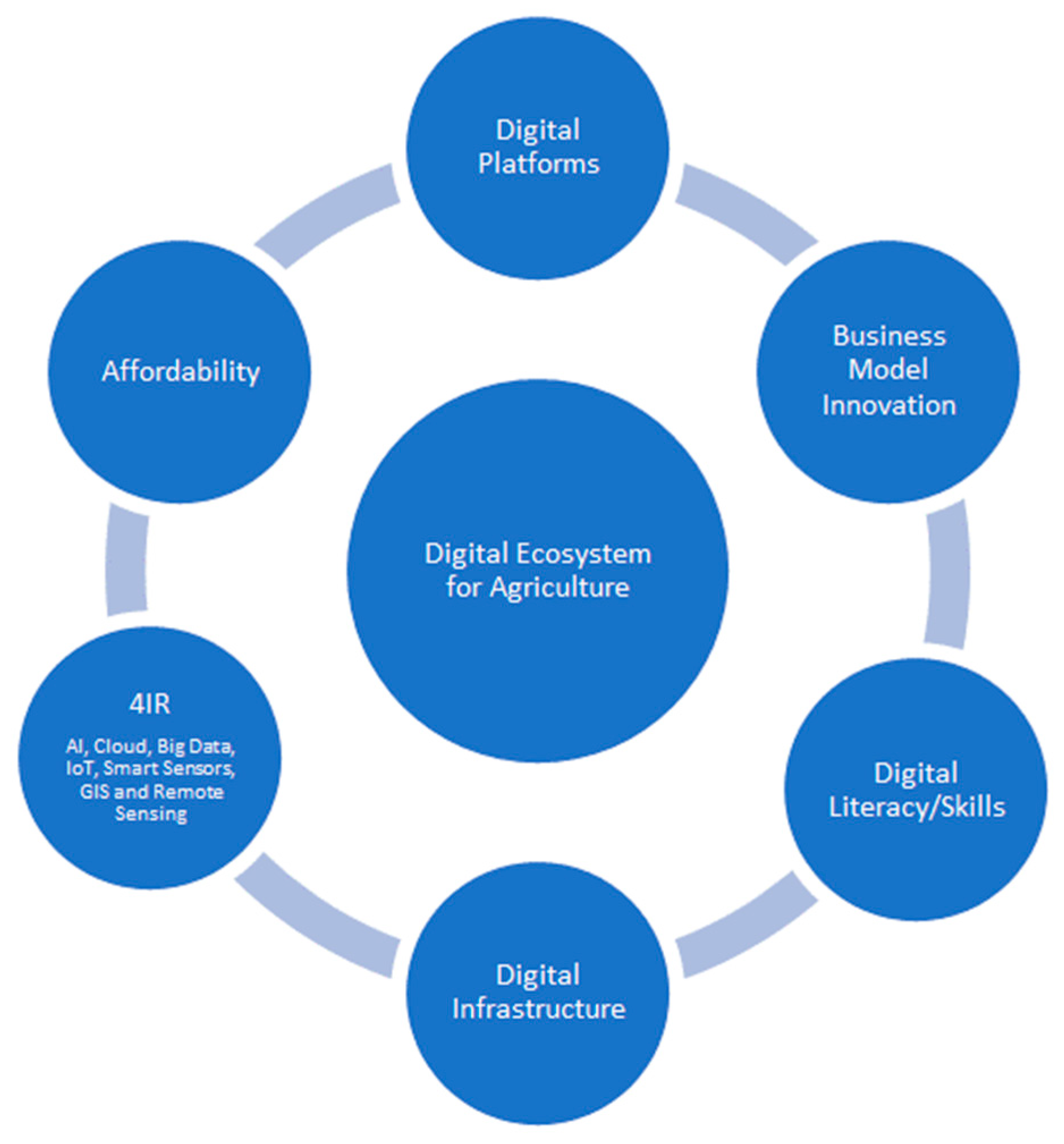
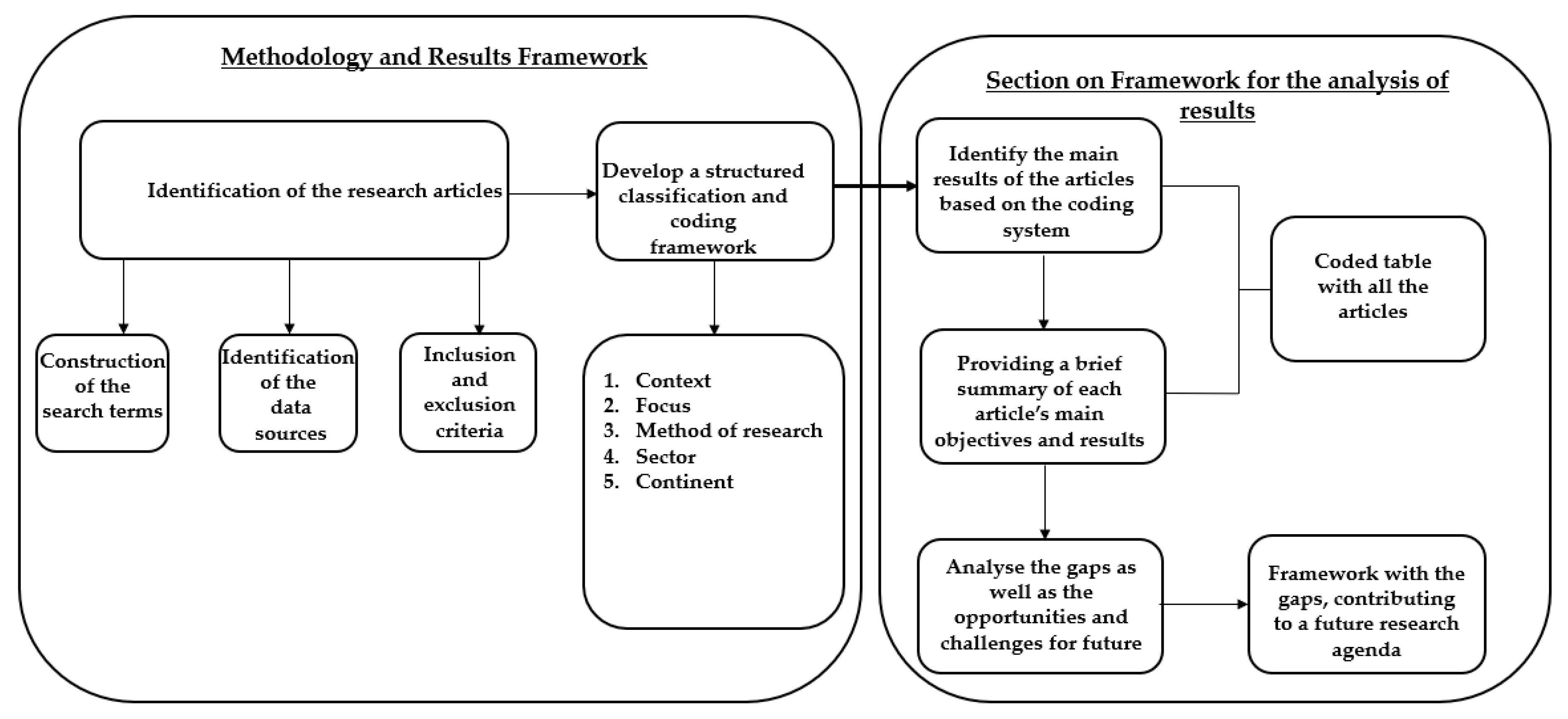
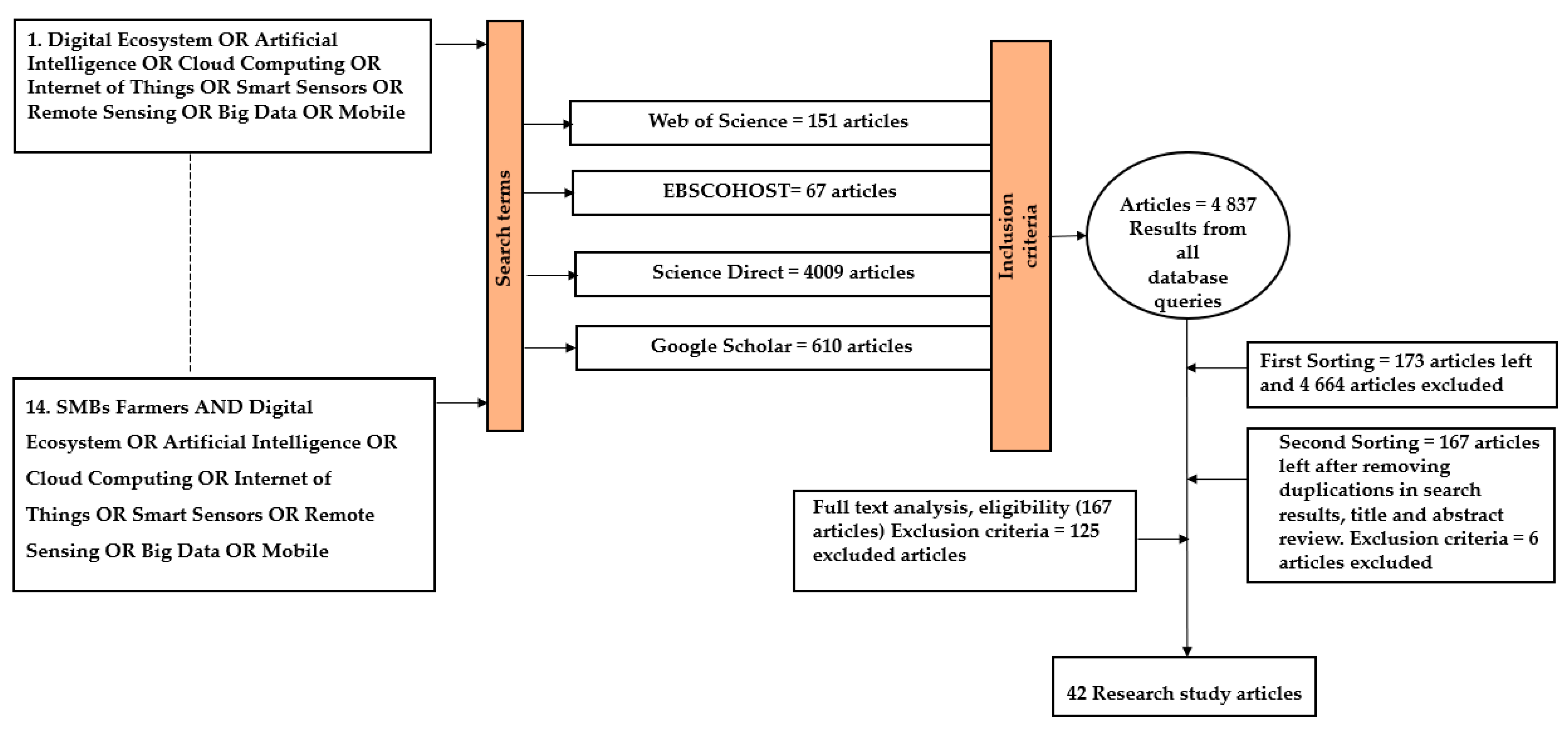
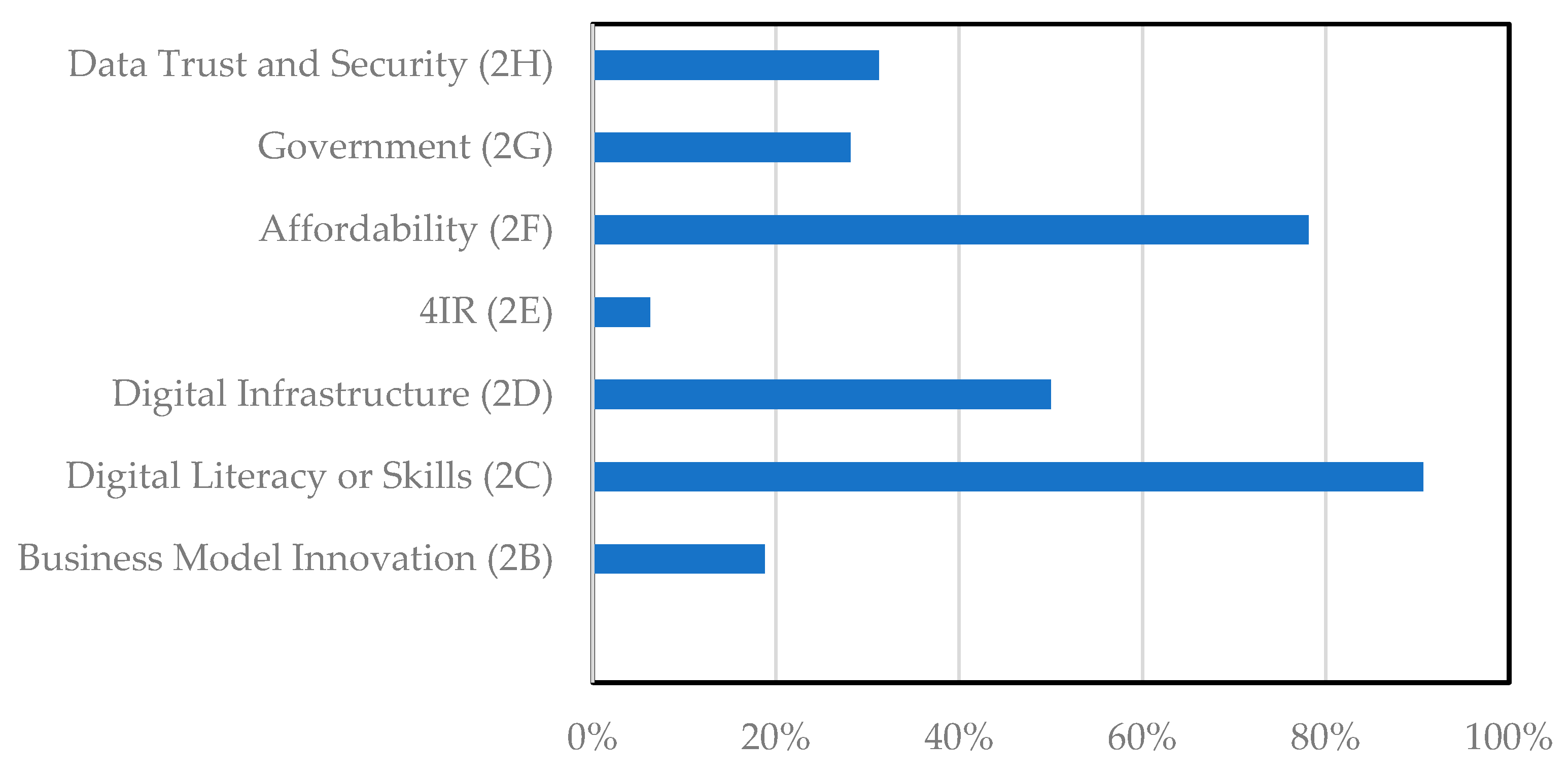
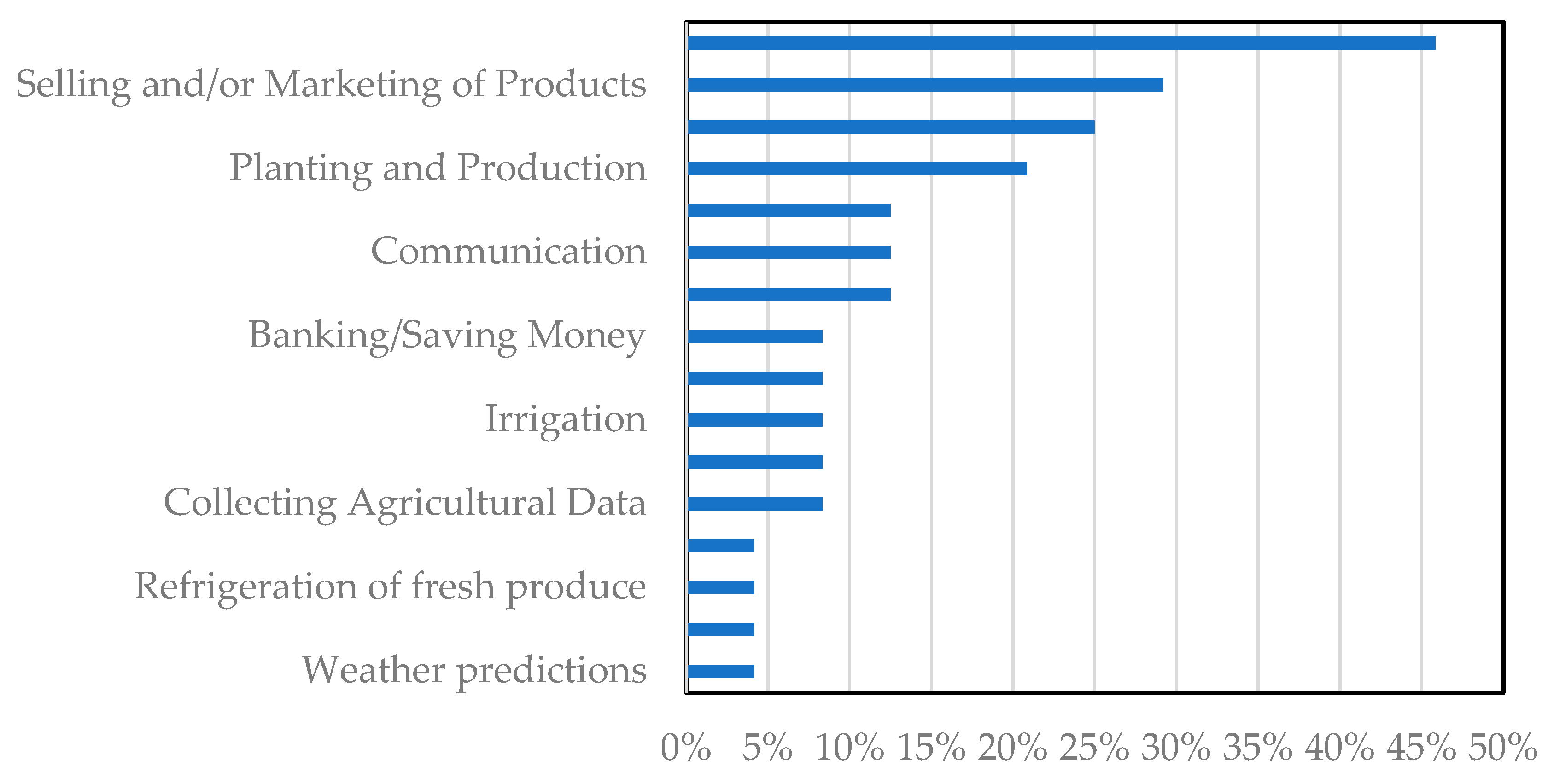
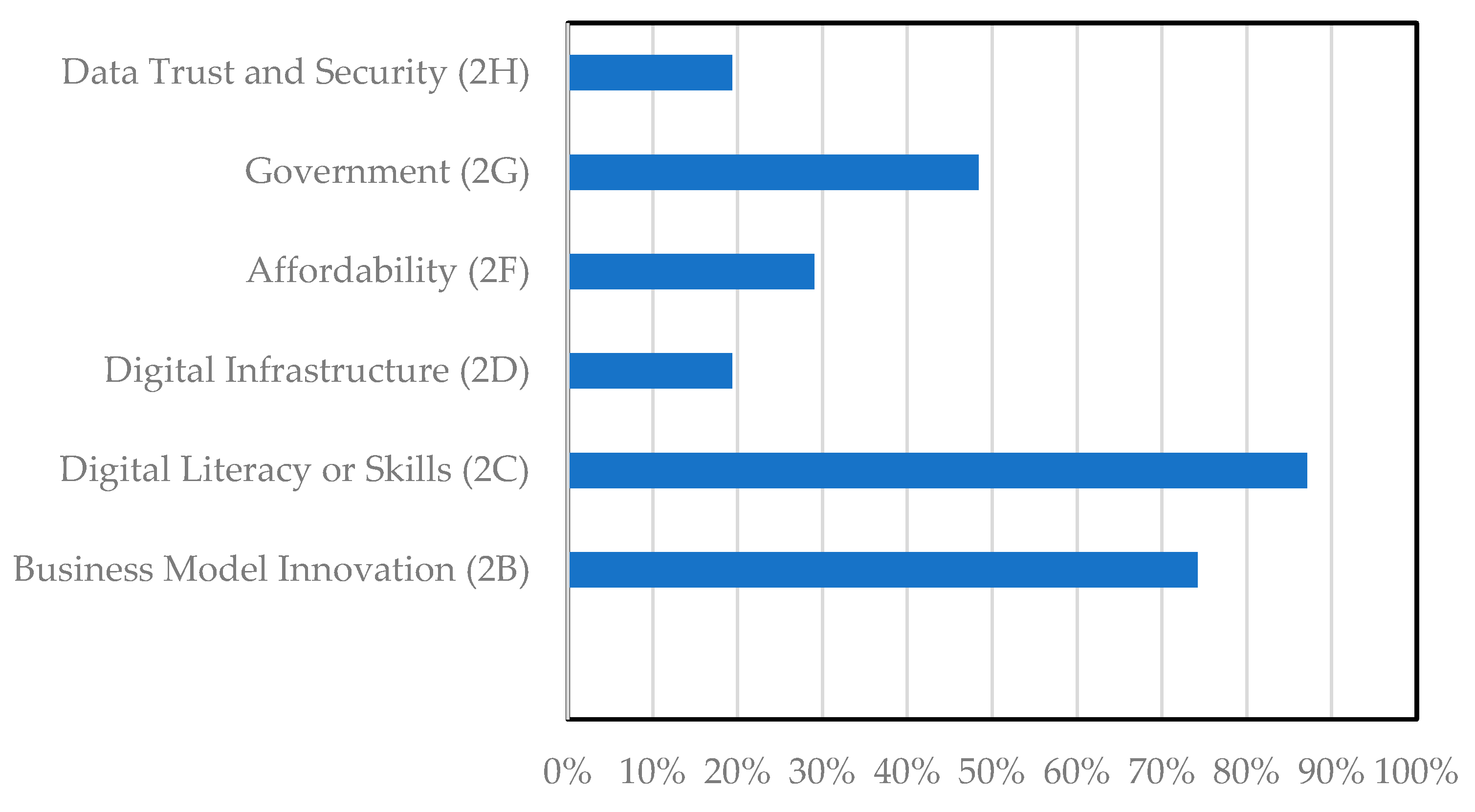
| Classification | Description | Codes |
|---|---|---|
| Context | Global | 1A |
| Sub-Saharan Africa | 1B | |
| South Africa | 1C | |
| Low- and middle-income countries | 1D | |
| Focus | Digital platform | 2A |
| Business model innovation | 2B | |
| Digital literacy or skills | 2C | |
| Digital infrastructure | 2D | |
| 4IR | 2E | |
| Affordability | 2F | |
| Method | Qualitative | 3A |
| Quantitative | 3B | |
| Theoretical | 3C | |
| Empirical | 3D | |
| Case studies/interviews | 3E | |
| Survey | 3F | |
| Design | 3G | |
| Sector | Agriculture | 4A |
| Not applicable | 4B | |
| Origin (continents) | America | 5A |
| Africa | Europe | 5B |
| Asia | 5C | |
| Africa | 5D | |
| Oceania | 5E |
| Context | No. of Articles | Research Context Code |
|---|---|---|
| Global level | 25 | 1A |
| Sub-Saharan Africa level | 12 | 1B |
| South Africa level | 4 | 1C |
| Low- and middle-income countries level | 1 | 1D |
| Research Methods | Qualitative 3A | Quantitative 3B | Theoretical 3C | Empirical 3D | Case Studies 3E | Survey 3F | Design 3G | No. of Articles |
|---|---|---|---|---|---|---|---|---|
| Single research methods | 0 | 0 | 7 | 0 | 0 | 0 | 4 | 11 |
| Mixed research methods | 5 | 5 | 1 | 1 | 2 | 2 | 0 | 16 |
| Qualitative | 13 | 0 | 2 | 1 | 11 | 4 | 1 | 32 |
| Quantitative | 0 | 12 | 0 | 3 | 8 | 8 | 2 | 33 |
| Elements of Digital Agriculture Ecosystem | Factors of Influence (Challenges) |
|---|---|
| Business model innovation (2B) |
|
| Digital literacy or skills (2C) |
|
| Digital infrastructure (2D) |
|
| 4IR (2E) |
|
| Affordability (2F) |
|
| Government (2G) |
|
| Data trust and security (2H) |
|
| Digital Agriculture Ecosystem Elements | Factors of Influence |
|---|---|
| Business model innovation (2B) |
|
| Digital literacy or skills (2C) |
|
| Digital infrastructure (2D) |
|
| Affordability (2F) |
|
| Government (2G) |
|
| Data trust and security (2H) |
|
Disclaimer/Publisher’s Note: The statements, opinions and data contained in all publications are solely those of the individual author(s) and contributor(s) and not of MDPI and/or the editor(s). MDPI and/or the editor(s) disclaim responsibility for any injury to people or property resulting from any ideas, methods, instructions or products referred to in the content. |
© 2023 by the authors. Licensee MDPI, Basel, Switzerland. This article is an open access article distributed under the terms and conditions of the Creative Commons Attribution (CC BY) license (https://creativecommons.org/licenses/by/4.0/).
Share and Cite
Gumbi, N.; Gumbi, L.; Twinomurinzi, H. Towards Sustainable Digital Agriculture for Smallholder Farmers: A Systematic Literature Review. Sustainability 2023, 15, 12530. https://doi.org/10.3390/su151612530
Gumbi N, Gumbi L, Twinomurinzi H. Towards Sustainable Digital Agriculture for Smallholder Farmers: A Systematic Literature Review. Sustainability. 2023; 15(16):12530. https://doi.org/10.3390/su151612530
Chicago/Turabian StyleGumbi, Nametshego, Lucas Gumbi, and Hossana Twinomurinzi. 2023. "Towards Sustainable Digital Agriculture for Smallholder Farmers: A Systematic Literature Review" Sustainability 15, no. 16: 12530. https://doi.org/10.3390/su151612530
APA StyleGumbi, N., Gumbi, L., & Twinomurinzi, H. (2023). Towards Sustainable Digital Agriculture for Smallholder Farmers: A Systematic Literature Review. Sustainability, 15(16), 12530. https://doi.org/10.3390/su151612530







